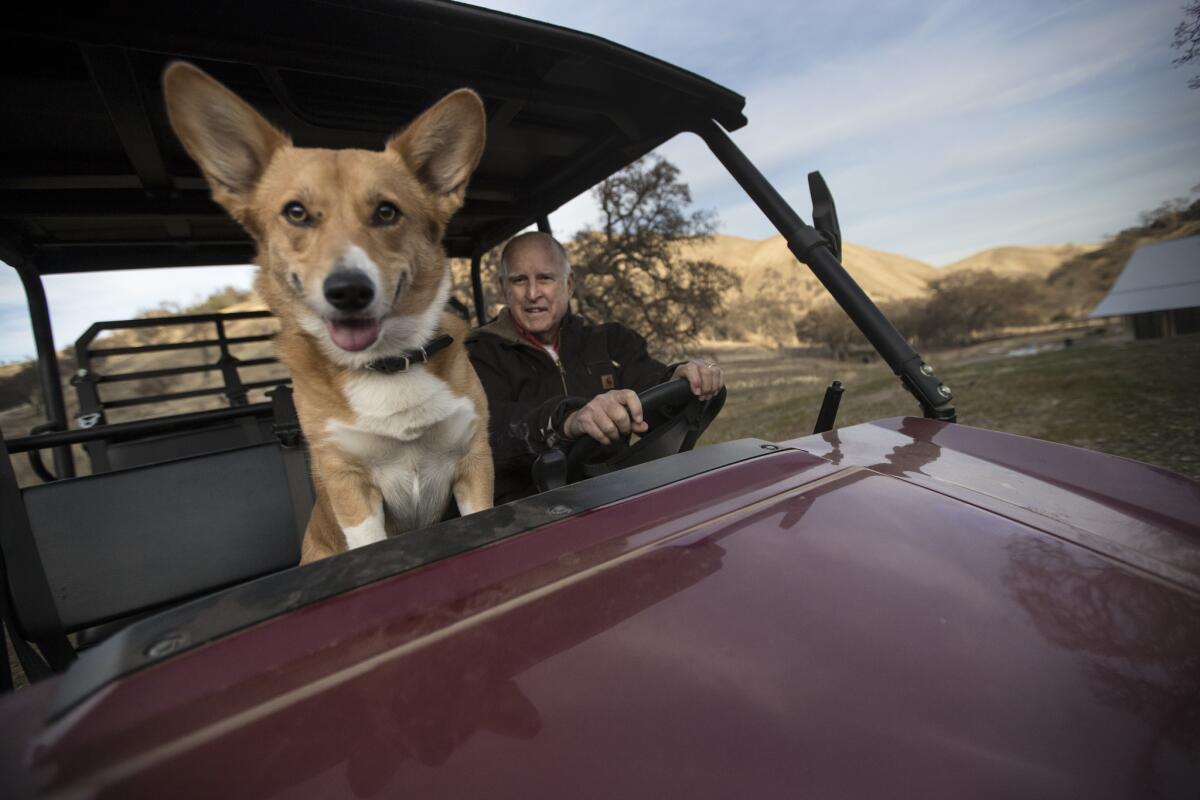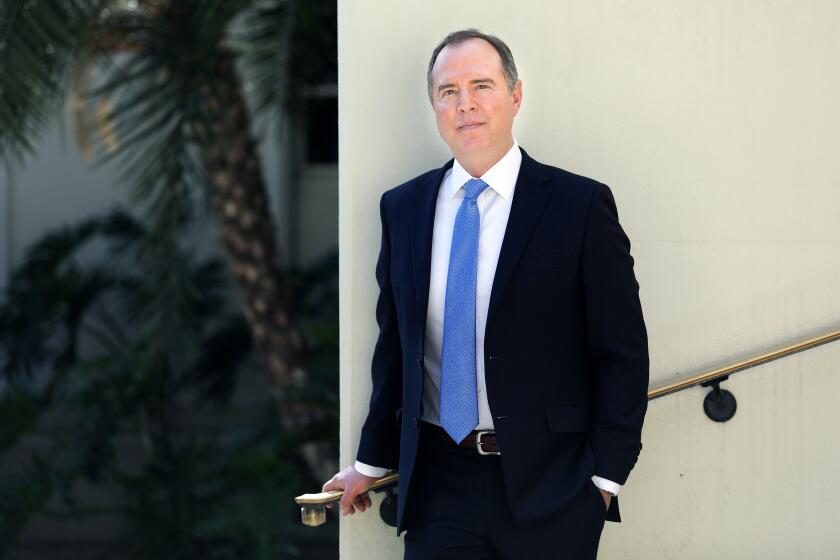Gov. Jerry Brown plants the seeds of his next chapter on a ranch in rural Northern California

- Share via

The thought lingered with Jerry Brown, perhaps sustained through the years by an old black-and-white photograph in his state Capitol office. The image is a man with a long, white beard feeding his sheep in a rustic 19th-century setting.
California’s longest-serving governor told himself that one day he should do something special with all of that rolling Northern California acreage that once belonged to his great-grandfather August Schuckman, the man in the photo.
“This land and this place put me in touch with the way people lived before,” Brown told The Times in an interview on a cold winter afternoon, sitting under a large oak tree on the Colusa County property his family calls Rancho Venada.
“In the evening, particularly when the moon comes up over the mountains, and the silver glow on the trees and the barns and the shapes of the mountains, it’s a feeling that I’m in the right place at the right time,” Brown said.
The sprawling cattle ranch, nestled in the low hills a few miles west of the town of Williams, is well-suited to Brown’s idiosyncrasies: solitary but accessible, historic but outfitted with cutting-edge technology, a home where he can think but also tinker.
“This is a fascinating place — the history, the ecology,” Brown said. “As a politician, particularly a state politician, you’re always about more general things — you know, proposing a law or a funding of something or other. Well, this is a lot more concrete.”
The governor and his wife, Anne Gust Brown, regularly make the 75-minute drive northwest from Sacramento as they put the finishing touches on their single-story, 2,700-square-foot home. Custom built in a shallow V-shape with an overhanging roof to provide shade in the heat of summer, it features a generous living room with a towering stone fireplace and floor-to-roofline windows. The house was designed to use as little electricity as possible. The governor’s office declined to comment on the cost of construction.
Here, the couple hope to write a new chapter in their lives, away from the public eye. “I want to get us on the path to something important,” said Gust Brown, who is taking the lead on many of the final tasks while the governor focuses on the policy agenda of his final year in office.
Some items on her to-do list are harder than others. “I’ve got to figure out what to do with all of his books,” Gust Brown said. “There are thousands of them.”
More coverage of California politics in Brown's final year in office »
The land was bought in 1877 by Brown’s great-grandfather Schuckman, a German immigrant who arrived in California during the Gold Rush and succeeded in “overcoming every obstacle,” as the governor put it in his 2011 inauguration speech. Schuckman’s ranch home also doubled as an inn, known to the family as the “Mountain House,” to capitalize on a stagecoach route bringing tourists to the region’s natural hot springs.
The homestead was purchased by a group including the governor’s father, the late Gov. Edmund “Pat” Brown, in the early 1960s. A family corporation now holds the deed to most of the ranch, and a portion of the shares and property belongs to Brown.
The new home is only a few yards away from where Schuckman’s house once stood. It will be dependent on solar energy — but not because the governor is one of the nation’s most vocal champions of renewable energy. Rancho Venada is off the grid because there is no electrical infrastructure in the area.
“There’s no choice,” the governor said. “If you want power, you’ve got to have solar. That’s what people have out here.”
His system is robust. It’s comprised of 48 solar panels, producing 14 kilowatt-hours of electricity and feeding almost double that amount of power into a series of lithium-ion batteries. A 24 kWh backup system, powered by natural gas, will be in place for the winter days when sunlight is sparse. Jason Andrade, who installed the system, said the governor has frequently called to pepper him with a variety of technical questions.
The idea of putting down roots is at odds with Brown’s otherwise peripatetic tendencies. He can quickly rattle off his many homes: Laurel Canyon in Los Angeles and Pacific Heights in San Francisco while governor in the 1970s, a converted waterfront warehouse while serving as Oakland mayor, a home in the Oakland hills he and his wife sold in 2016 in favor of moving into the historic governor’s mansion.
“I think they each fit a certain period in my life,” Brown said.
This home he likens to “reinhabiting a place, which is really a second life to someplace.”
The ranch also will offer a second life to Brown, one away from politics. The first exodus began after losing the U.S. Senate race in 1982 and leaving the governor’s office soon after. Brown then embarked on stints with the late Mother Teresa in India and Zen Buddhists in Japan, making his way back to become chairman of the California Democratic Party in 1989. From there, it was two terms as mayor of Oakland and one as California’s attorney general before winning back the governorship in 2010.
MORE: 'Be loyal to the idea of California,' says Gov. Jerry Brown »
That long résumé may be why some refuse to believe that Brown, who turns 80 in April, is really retiring. After all, he has become the nation’s unofficial ambassador on climate change and called President Trump “a danger” during the interview with The Times on his ranch.
“I think there are a lot of problems to handling him,” Brown said of Trump. “This is a real dilemma, for America and the world. And certainly for the Democrats.”
Those who hope the iconic Californian makes a fourth bid for the White House — a senior statesman on the campaign trail in Iowa or New Hampshire — may be disappointed to learn that Brown seems most happy on the trail that runs along a ridgeline at Rancho Venada. It’s here that he frequently takes visitors for a white-knuckle ride in one of the ranch’s all-terrain vehicles. His dog, Colusa, is usually by his side. Sutter, the family’s famous corgi who died in 2016, is buried on the ranch.
RELATED: 'Be loyal to the idea of California,' says Gov. Jerry Brown »
“They think you tend to do what you’ve always done,” the governor said about the constant political speculation during a ride up that trail. “And most of my life has been running for office.”
Brown insists there’s more than enough real work on the ranch to keep him occupied. Contractors were quizzed on a recent afternoon about why the water level was so low in a hillside storage tank. Then he wondered what to do if big rocks again come tumbling down the hillside during the year’s seasonal rains.
“I mean, it’s never-ending,” the governor said. “There’s plenty to do here, governing this piece of land.”
Not that he’s ready to give up politics altogether.
Brown said he is considering a number of ideas for 2019 and beyond — from being a college lecturer to funding a ballot initiative or other political efforts with his $15-million campaign war chest.
“My ambitions, they have some vitality to them,” he said. “I don’t live in a world where I have my agenda all done.”
That agenda, though, will be crafted from a home base where California’s most famous Democrat is outnumbered. Brown handily lost Colusa County in the 2006, 2010 and 2014 statewide elections. He remembers voters here just barely favored his father over Republican Richard Nixon in the governor’s race of 1962.
But he’s already thinking about how an ambitious newcomer, one with a little experience, could shake up the local political scene.
“Colusa County, you know, is the only county without a Democratic central committee,” Brown said with a slight smile. The former mayor of Williams, he said, wants to form a local branch of the party. “They’re very anxious to get me.”
Follow @johnmyers on Twitter, sign up for our daily Essential Politics newsletter and listen to the weekly California Politics Podcast
Get the L.A. Times Politics newsletter
Deeply reported insights into legislation, politics and policy from Sacramento, Washington and beyond. In your inbox three times per week.
You may occasionally receive promotional content from the Los Angeles Times.







